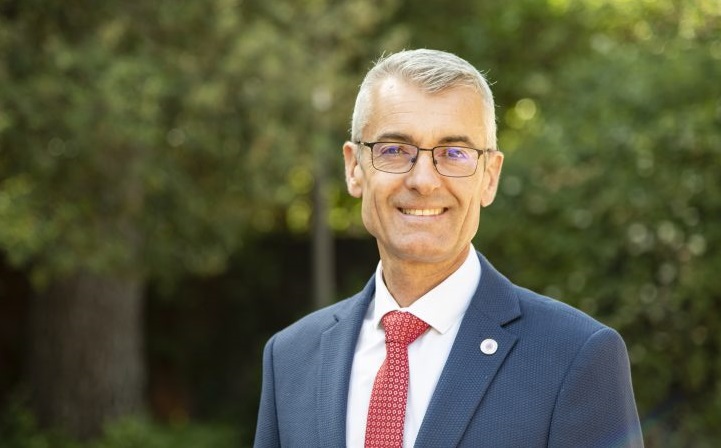11 Dec 2024

Tired Earth
By The Editorial Board

Captain Laurent Alfonso, a fire officer, European Affairs Officer at the Directorate General for Civil Security and Crisis Management, European and International Relations Mission and Seconded National Expert on civil protection at the Union for the Mediterranean, spoke to EURACTIV France.
The EU’s Civil Protection Mechanism has been activated more than 600 times by EU member states and six other partners. Its objective is to enable a country to assist another one facing a natural or technological disaster. The EU has reinforced this mechanism with a specific complementary protocol, RescEU, which has acquired a fleet of 12 Canadair aircraft to fight wildfires, which France used this summer.
This summer, five different countries activated the EU Civil Protection Mechanism nine times. Can we say that the EU has responded to wildfires that have already burned 700,000 hectares of forest?
Absolutely. The Civil Protection Mechanism has been able to meet the expectations of the various countries that have activated it, even though the forest fire season is not over yet.
Thanks to past experiences, we can now have visibility on the level of risk in each country, anticipate the needs at any time and ensure the availability of the means of intervention. All this is done two, three or even five days in advance, thanks to the European EFFIS (European Forest Fire Information Service) platform.
There can be obstacles, especially when major events coincide. In July, Italy could not send its two Canadairs immediately to France, which had requested them, due to strong national demand. However, these were quickly replaced by aircraft from Greece and Sweden.
The Commission’s objective is to double the European fleet, rescEU, by 2029, increasing from 12 to 24 aircraft stationed in Portugal, Spain, France, Italy, Croatia and Greece. But what is Europe doing to prevent those wildfires?
RescEU is only the final step in terms of capability response. A considerable effort is being made upstream to improve early warning, analysis and risk assessment systems.
For example, a 2018 European directive required states to have a national public alert system via cell phones. This allows individuals to be notified of the nature of the risk, its location and the proper ways to behave. Thanks to the Galileo GPS, the EU will soon be able to inform and notify European citizens by sending them text messages via satellites.
Prevention is all the more important as the risk of forest fire spreads to northern and eastern Europe. Slovenia and the Czech Republic have both activated the mechanism this summer. Civil protection must be brought into European homes, and everyone must contribute to making our societies resilient.
How should civil protection adapt in the face of global warming?
We realise that the type of natural risks has changed. We must be ready to intervene anytime, anywhere and in any emergency. In 2021, devastating floods hit Germany in July, in the middle of summer! Climate change reinforces the random aspect of disasters.
As a result, interventions are becoming more complex. We have to be able to manage evacuations and take into consideration the societal and economic consequences. This involves many local, national and supranational services. How can we incorporate 360 European firefighters, as was the case in France this summer, into a national response system with the language barriers and the organisational problems that this entails? The governance of complex risk management is a challenge we must overcome and will undoubtedly be discussed this autumn.
Using satellite imagery, the Copernicus Emergency Management Service (CEMS) is a real European success story. Can Europe count on technological progress in the field of civil protection?
A knowledge network is currently being set up to link the scientific and operational sectors in managing natural and technological risks. This is the purpose of the NEMAUSUS project that was initiated in 2021 and is intended to create a European centre of expertise on forest fires in Nîmes, the city hosting the French Civil Protection Base.
Experts are working on several scenarios to develop resilience to unprecedented climatic events. They are also thinking about designing thinner, more flexible jackets for firefighters, drones that can anticipate fire propagation, and all sorts of technologies for alerting the population.
Southern countries also inspire Europe…
The Mediterranean basin is a “hot spot”, an area that is warming up faster than any other, as shown by the Mediterranean Experts on Climate and Environmental Change (MedECC). The devastating fires in Morocco and Algeria this summer are evidence of this.
However, over the years, these countries have adapted and fine-tuned their intervention protocols, land and air resources, and uniforms. Firefighters know how to work in extremely hot environments, 40 to 45 degrees. Moreover, they have learned to deal with natural risks throughout their territory. This is what we will have to develop in Europe.
As beneficiaries of the EU’s Civil Protection Mechanism, the South’s countries are strengthening their national capacities by aligning themselves with our common standards.
Are we moving towards a true European civil protection force?
There is still room for further development for optimising the full potential of the Union’s Civil Protection Mechanism. We can still develop the rescEU capacity, which the Commission is doing by financing new aircraft. We can also go faster in deploying our response capabilities in terms of prevention and preparation.
This year, we have been testing “pre-positioning”. Six member states – Bulgaria, Finland, France, Germany, Norway and Romania – have sent more than 200 European firefighters to Greece as a matter of anticipatory safety during times of vulnerability. This could be generalised and systematised.
Lastly, member states can discuss increasing the EU’s competencies in civil protection in the future. For the time being, it remains a national competence. The debate has been launched. But we still have a lot of leeway regarding European collaboration and cooperation.
Source : euractiv.com
Comment